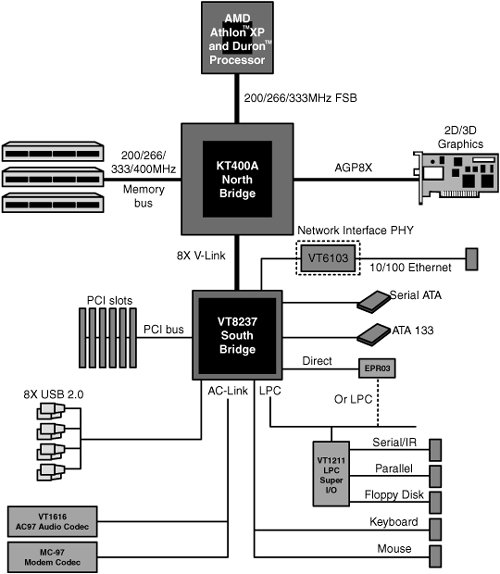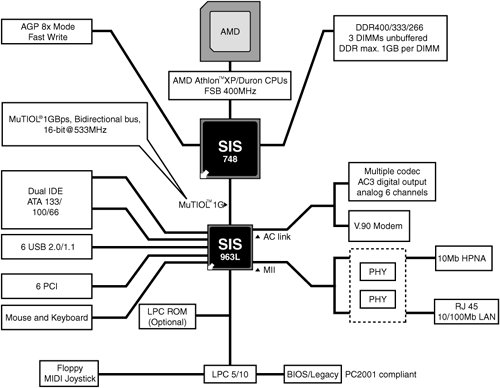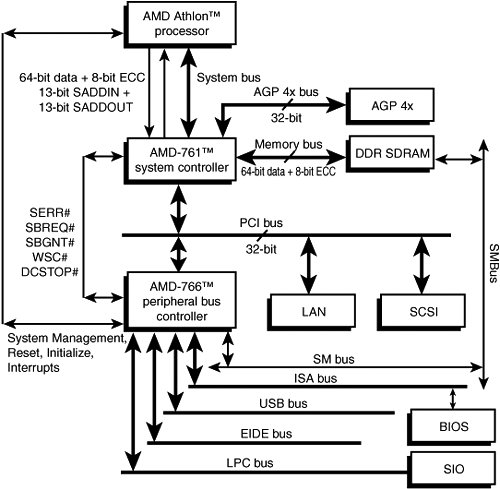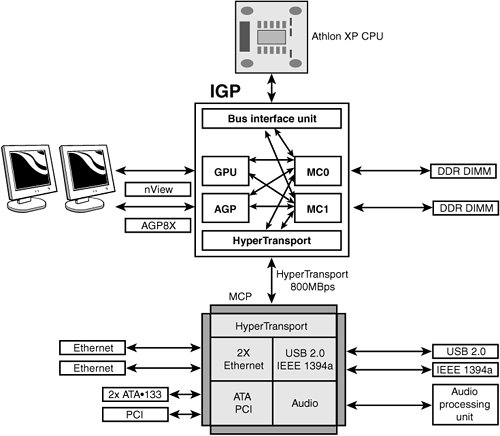AMD AthlonAthlon XPDuron Chipsets
AMD Athlon/Athlon XP/Duron ChipsetsThe original AMD Athlon was a Slot A processor chip, but subsequent versions used Socket Aas do do the Athlon XP, Duron, and some versions of the Sempron. Although similar in some ways to the Pentium III and Celeron, the AMD chips use a different interface and require different chipsets. AMD was originally the only supplier for Athlon chipsets, but VIA Technology, ULi Electronics, SiS, and NVIDIA now provide a large number of chipsets with a wide range of features. These chipsets are covered in the following sections. AMD Chipsets for Athlon and Athlon XPAMD makes four chipsets for Athlon and Duron processors: the AMD-750 and AMD-760/MP/MPX. The major features of these chipsets are compared in Table 4.43 and described in greater detail in the following sections.
AMD-750AMD's first chipset for its own Slot A and Socket A processors, called the AMD-750, is a traditional North/South Bridge design specifically for the Athlon and Duron processors. The AMD-750 chipset consists of the AMD-751 North Bridge and the AMD-756 South Bridge. The AMD-751 system controller connects between the AMD Athlon processor bus to the processor and features the memory controller, AGP 2x controller, and PCI bus controller. The AMD-756 South Bridge includes a PCI-to-ISA bridge, USB controller interface, and ATA 33/66 controller. The AMD-750 chipset includes the following features:
AMD-760 FamilyThe AMD-760 chipset was introduced in October 2000 and is notable as the first chipset supporting DDR SDRAM memory. The AMD-760 chipset consists of the AMD-761 system controller (North Bridge) in a 569-pin plastic ball-grid array (PBGA) package and the AMD-766 peripheral bus controller (South Bridge) in a 272-pin PBGA package. See Figure 4.42 for details of the 760's block diagram. Figure 4.42. AMD-760 chipset block diagram. The AMD-761 North Bridge features the AMD Athlon system bus, DDR-SDRAM system memory controller with support for either PC1600 or PC2100 memory, AGP 4x controller, and PCI bus controller. The 761 allows for 200MHz or 266MHz processor bus operation and supports the newer Athlon chips that use the 266MHz processor (also called front-side) bus. The AMD-766 South Bridge includes a USB controller, dual UDMA/100 ATA/IDE interfaces, and theLPC bus for interfacing newer Super I/O and ROM BIOS components. The AMD-760 chipset includes the following features:
The AMD-760MP chipset, which uses the AMD-762 North Bridge chip, is a development of the basic AMD-760 design that supports dual-processor Athlon MP systems. It differs from the standard 760 chipset in the following ways:
The AMD-760MPX chipset uses the same AMD-762 North Bridge chip as the AMD-760MP to support multiple Athlon MP processors, but it uses the AMD-768 peripheral bus controller (South Bridge) chip. It differs from the 760MP chipset in the following ways:
The 760MPX chipset is a better choice for a server because of its support for 66MHz and 64-bit PCI slots, whereas the 760MP is a suitable choice for a workstation. None of these chipsets support USB 2.0, ATA-133, or DDR333 or faster memory. If you buy an Athlon, a Duron, or an Athlon XP desktop system, it's far more likely that your system will contain a third-party chipset than an AMD chipset; however, the 760MP and 760MPX chipsets continue to be popular choices for AMD-based workstations and servers. The following sections cover the third-party chipsets made for the Athlon, Duron, and Athlon XP processors. VIA Chipsets for Athlon and Athlon XPVIA Technologies, Inc., is the largest chipset and processor supplier outside of Intel and AMD. Originally founded in 1987, VIA is based in Taipei, Taiwan, and is the largest integrated circuit design firm on the island. VIA is a fabless company, which means it farms out the manufacturing to other companies with chip foundry capability. Although it is best known for its chipsets, in 1999 VIA purchased the Cyrix processor division from National Semiconductor and the Centaur processor division from IDT, respectively, thereby becoming a supplier of processors in addition to chipsets. VIA has also formed a joint venture with SONICblue (formerly S3) as a means of integrating graphics capabilities into various chipset products. This joint venture is known as S3 Graphics Co., Ltd. VIA makes chipsets for Intel, AMD, and Cyrix (VIA) processors. Table 4.44 provides an overview of VIA's Athlon/Duron chipsets that use the traditional North/South Bridge architecture.
More recently, VIA has converted to an architecture called V-Link, which uses a fast dedicated connection between the North Bridge and South Bridge. V-Link is similar to Intel's hub architecture, as well as HyperTransport (used by ALi, NVIDIA, and ATI), MuTIOL (used by SiS), and A-Link (used by ATI). V-Link is also used by VIA's Pentium 4 chipsets. Tables 4.4547 provide an overview of V-Link chipsets, which also support the VIA Modular Architecture Platform (V-MAP) design. As with VIA's chipsets for the Pentium 4, V-MAP uses identical pinouts for several ranges of V-Link North and South Bridge chips so vendors can reuse a motherboard design with more advanced chipsets as they are developed.
Both types of chipsets are discussed in the following sections. VIA Technologies Apollo KX133The VIA Apollo KX133 chipset brings AGP 4x, PC133, a 200MHz FSB, and ATA-66 technologies to the AMD Athlon processor platform, exceeding the performance of AMD's own 750 chipset. It was the first chipset to support AGP 4x. Key features include the following:
The VIA Apollo KX133 is a two-chip set consisting of the VT8371 North Bridge controller and the VT82C686A South Bridge controller. VIA Technologies Apollo KT133 and KT133AThe VIA Apollo KT133/A chipsets are designed to support the AMD Athlon and Duron processors in Socket-A (462) form. Based on the prior KX133 chipset, the KT133/A differ mainly in their support for Socket-A (462) over the previous Slot-A processor interface. The VIA Apollo KT133 and KT133A are both two-chip sets consisting of the VT8363 North Bridge and the VT82C686A South Bridge (KT133) or the VT8363A North Bridge and the VT82C686B South Bridge (KT133A). Both the KT133 and KT133A support the following standard features:
The KT133A (VT8363A North Bridge with VT82C686B South Bridge) adds the following features:
ProSavage KM133The VIA ProSavage KM133 integrates S3 Graphics' S3 Savage 4 and S3 Savage 2000 3D and 2D graphics engines with the Apollo Pro KT133 chipset. The major features of the chipset are the same as for the Apollo Pro KT133, with the following additions:
An optional AGP 4x interface enables the integrated AGP 4x video to be upgraded with an add-on card if desired. This two-chip chipset consists of the VT8365 North Bridge and VT8231 South Bridge. The VT8231 South Bridge integrates the Super I/O and supports the LPC interface. Apollo KT266 and KT266AThe Apollo KT266 is the first VIA chipset for Athlon-based systems to support VIA's high-speed V-Link system architecture. V-Link connects the 552-pin VT8366 North Bridge to the 376-pin VT8233 series South Bridge with a 266MBps data pathway, which is twice as fast as traditional PCI-based connections. Major features of the KT266 include system bus speeds of 200/266MHz, AGP 2x/4x interface, and up to 4GB of DDR200/266 DDR SDRAM or PC100/133 SDRAM. Other features vary with the South Bridge (VT8233, VT8233A, or VT8233C) chip used with the VT8366. The KT266A is a pin-compatible upgrade to the original KT266's North Bridge. The KT266A's VT8366A includes VIA's Performance Driven Design, which is not a technical term but a marketing term for the A-series' chips improved memory timing and deeper command queues to improve chipset performance. Basic features of the KT266A are otherwise similar to the KT266. ProSavage KM266The ProSavage KM266 combines the features of the KT266 with the graphics core of the S3 Graphics ProSavage 8 2D/3D accelerator. Unlike some other chipsets with integrated graphics, the KM266 retains an AGP 4x slot, so users can upgrade to faster AGP 4x graphics in the future. The ProSavage8 core uses 32MB of system RAM for its frame buffer, supports AGP 8x bandwidth internally with 128-bit data paths, and features DVD DXVA Motion Compensation to improve the quality of DVD playback. It supports all members of the VT8233 family of South Bridge chips and has a 266MBps 4x V-Link connection between North and South Bridge chips. Apollo KT333The Apollo KT333 is a pin-compatible development of the KT266A, adding support for a 333MHz system bus, 333MHz memory bus, and DDR333 memory. Unlike the KT266A, the KT333 no longer supports PC100/133 memory, but it uses the same KT8233 family of South Bridge chips. Apollo KT400/KM400The Apollo KT400 is the first VIA chipset for the Athlon XP processor to offer AGP 8x and a second-generation 533MB/s V-Link connection to the South Bridge. It uses the VT8235 South Bridge, which is VIA's first South Bridge chip to support USB 2.0 as well as ATA-133. The combination of faster video, fast memory and system bus speeds, and faster V-Link connections make the KT400 among the fastest Athlon XP chipsets. The KM400 has the same basic features as the KT400 but adds integrated UniChrome 2D/3D graphics developed by S3 Graphics. The KM400 can be matched with the VT8235CE South Bridge chip or the top-of-the-line VT8237 South Bridge chip introduced by the KT400A (see the next section). Apollo KT400A/KT600In previous A-series chipsets from VIA, the North Bridge component was replaced with an improved chip and the South Bridge component was retained. However, the KT400A features new designs for both its North Bridge (VT8377A) and South Bridge (VT8237) chips. The major features of the VT8377A component include
Some motherboard vendors use the older VT8235CE South Bridge chip (refer to Table 4.45) with the VT8377A North Bridge component. However, when the VT8237 South Bridge is used, the KT400A chipset has these new features:
KT400A's FastStream64 enables the system to reach 3.2GBps memory transfer speeds without the need for more expensive dual-channel memory support. Figure 4.43 shows the architecture of the KT400A (with VT8237) chipset. The VIA KT600 is an improved version of the KT400A/VT3237 combo, adding support for the 400MHz CPU bus versions of the Athlon XP. Although a few motherboards pair the KT600's North Bridge with the older VT8235CE South Bridge, most motherboard vendors use the KT600/VT8237 combo to provide support for Serial ATA, SATA RAID, and other advanced features. KT880The VIA KT880 is VIA's first dual-channel chipset for the Athlon XP. Dual-channel memory support enables the system to reach very high memory transfer rates. It has the following features:
Figure 4.43. VIA KT400A block diagram. Silicon Integrated Systems Chipsets for AMD Athlon and Athlon XPSiS has a variety of chipsets for the Athlon, Duron, and Athlon XP processors. Tables 4.47 and 4.48 provide an overview of these chipsets, some of which use a single-chip design and others of which use a high-speed two-chip design similar to other vendors' chipsets. These chipsets are discussed in the following sections.
SiS MuTIOL High-Speed North/South Bridge ConnectionThe SiS96x-series South Bridge chips use a high-speed bus called MuTIOL to connect with compatible North Bridge chips. The original version of MuTIOL (supported by the SiS961- and 962-series chips) is a 16-bit wide 266MHz connection that provides 533MBps bandwidth, twice the speed of the Intel hub architecture used by Intel's 800-series chipsets. The SiS963-, 964-, and 965-series and matching North Bridge chips use a second generation of MuTIOL called MuTIOL 1G, which supports a 16-bit-wide 533MHz connection to achieve bandwidths exceeding 1GBps. When connected to the SiS746FX, SiS741GX, SiS748, or SiS741 North Bridge chips and newer models, the SiS963/964-series chips use a further development of MuTIOL called HyperStreaming, which integrates the following four technologies to further improve the speed of data transfer:
SiS730SThe SiS730S is a high-performance, low-cost, single-chip chipset with integrated 2D/3D graphics and support for Socket A versions of the AMD Athlon and Duron. The integrated video is based on a 128-bit graphic display interface with AGP 2x performance. In addition to providing a standard analog interface for CRT monitors, the SiS730S also provides the DFP for a digital flat panel monitor. An optional SiS301 video bridge supports NTSC/PAL TV output. The SiS730S also supports an AGP 4x slot, enabling users to upgrade to a separate AGP card in the future. The SiS730S also includes integrated 10/100Mb Fast Ethernet as well as an AC'97-compliant interface that comprises a digital audio engine with 3D-hardware accelerator, on-chip sample rate converter, and professional wavetable along with separate modem DMA controller. SiS730S also incorporates the LPC interface for attaching newer Super I/O chips and a dual USB host controller with six USB ports. The SiS730S can also be used with ISA slots if an optional LPC/ISA bridge chip is used. Features of the SiS730S include
SiS733 and SiS735The SiS733 and SiS735 are high-performance single-chip sets that support the AMD Athlon and Duron Socket A processors. Similar to other SiS single-chip sets, the SiS733 and SiS735 incorporate the features of a traditional North Bridge, South Bridge, and Super I/O chip into a single chip. The SiS733 supports PC133 SDRAM and uses a 682-pin BGA package. The SiS735 supports either PC133 or DDR266 SDRAM and integrates 10/100 Fast Ethernet and HomePNA 1Mbps/10Mbps Home Network interfaces. The SiS735 also uses a 682-pin BGA package. The SiS733 and SiS735 share the following features:
SiS740The SiS740 is a dual-chip design that provides a high-speed integrated video solution for Athlon-class processors. Its North Bridge and South Bridge chips use the high-speed MuTIOL connection to transfer data. Its major features include
It is designed to use the SiS961- or 962-series South Bridge chips. SiS745The SiS745 is the first single-chip solution to integrate IEEE 1394a (FireWire 400) as part of its I/O. It is designed to provide a high-performance legacy-free solution. Its key features include the following:
SiS746 and SiS746FXThe SiS746 is the first Athlon/Duron/Athlon XPcompatible chipset on the market to feature an AGP 8x interface. It is a two-piece chipset designed to connect with the SiS963-series South Bridge chipsets. Major features include
The companion SiS963L South Bridge chip adds the following features: ATA-133 support, six USB 2.0 ports, six-channel AC'97 audio, and MII interface for HomePNA or 10/100 Ethernet networking. The SiS963 South Bridge chip adds IEEE 1394a (FireWire 400) support. The SiS746FX North Bridge is an enhanced version of the SiS746, adding support for the 333MHz processor bus and approved DDR400 memory. It also uses the SiS963 series of South Bridge chips and uses SiS HyperStreaming technology to reduce latency in the MuTIOL interface. SiS748Like the SiS746FX, the SiS748 also uses the SiS963 series of South Bridge chips, as well as the SiS HyperStreaming technology for a lower-latency connection between the chips. Its other major features include
Figure 4.44 shows the system architecture of the SiS748 chipset when using the SiS963L South Bridge chip. If the SiS963 South Bridge chip is used in place of the SiS963L pictured, three IEEE 1394a ports are also available. Figure 4.44. Block diagram for SiS748 chipset with SiS963L South Bridge. SiS741/741GXThe SiS741 chipset includes integrated SiS Mirage Graphics. Its other features are similar to those of the SiS748 chipset. Major features include
The SiS741GX also includes integrated SiS Mirage Graphics. Its other features are similar to those of the SiS746FX, but it is usually paired with the SiS964 South Bridge. When paired with an SiS964-series South Bridge, the SiS741GX also supports the following:
ULi (ALiMagik1) for AthlonALi Corporation (now known as ULi Electronics) makes only one chipset for AMD Athlon/Duron processors: the ALiMagik1. ALiMagik1 is a two-chip chipset that uses the M1647 Super North Bridge and the M1535D+ South Bridge (which is also used by its Pentium III/Celeron chipsets). The M1647 Super North Bridge is a 528-pin BGA chip. The M1647 Super North Bridge supports SDRAM as well as DDR SDRAM at speeds of 200MHz or 266MHz. It supports up to 3GB of RAM but does not support ECC. Memory timing is x-1-1-1-1-1-1-1 in back-to-back SDRAM reads. Because the M1647 supports both conventional and DDR SDRAM, system manufacturers can use the same chipset for both memory types. The M1647 supports AGP 4x video, PCI 2.2, up to six PCI masters beyond the North Bridge and PCI bridge, ACPI and Legacy green power management, PCI Mobile CLKRUN#, and AGP Mobile BUSY#/STOP#. When combined with an M1535+ South Bridge chip, the chipset is called the MobileMagik1 and can be used on Athlon- or Duron-based portable systems. Because this chipset, unlike others that use DDR memory, still uses the traditional 133MBps PCI bus connection between North and South Bridge chips, its performance is among the lowest of any Athlon chipset. This chipset is now discontinued. NVIDIA nForce Chipsets for Athlon and Athlon XPNVIDIA, although best known for its popular GeForce line of graphics chipsets, has also become a popular vendor of chipsets for the AMD Athlon/Duron/Athlon XP processor family with its nForce and nForce2 product families. nForce's advanced features include
nForce2 improvements over nForce include the following:
Table 4.49 provides an overview of the North Bridge chips in the nForce and nForce2 families, and Table 4.50 provides an overview of the nForce/nForce2 South Bridge chips. The nForce is a descendant of the custom chipset NVIDIA created for the Microsoft Xbox console game system.
nForce North Bridge chips with integrated graphics are known as integrated graphics processors (IGPs), whereas those that require separate AGP video are known as system platform processors (SPPs). All South Bridge chips are known as media and communications processors (MCP). IGP/SPP and MCP chips communicate over an 800MBps HyperTransport connection. The combination of advanced memory controllers, prefetch design, HyperTransport high-speed connection, and hardware audio processing in MCP-D and MCP-T chips makes the second-generation nForce2 chipsets among the fastest chipsets available for Athlon XP processors. The new Gigabit MCP and RAID MCP chips bring eight-port USB 2.0 and Serial ATA/ATA RAID support to nForce2-based systems. The Gigabit MCP is the first nForce2 MCP chip to offer integrated Gigabit Ethernet. Figure 4.45 shows the architecture of the nForce2 IGP and MCP-T combination, which provides the greatest versatility. If the SPP North Bridge is used instead of the IGP, integrated video is not present. If the MCP South Bridge is used instead of the MCP-T, IEEE 1394a, hardware 5.1 Dolby Digital audio, and dual network ports are not available. Figure 4.45. NVIDIA nForce2 IGP/MCP2 chipset architecture. ATI Radeon IGP ChipsetsATI made a series of chipsets for the Athlon series of processors that integrate Radeon VE-level 3D graphics, DVD playback, and dual-display features with high-performance North Bridge and South Bridge designs. These chipsets use ATI's high-speed A-Link bus to connect its North and South Bridge chips, but they also support connections to third-party South Bridge chips via the PCI bus. This has enabled system designers to create an all-ATI or a mix-and-match solution. Many of the first Radeon IGP-based systems on the market used ALi (now ULi) or VIA South Bridge chips. The Radeon IGP 320 North Bridge chip can be matched with either of ATI's South Bridge chips: the IXP 200 or IXP 250. Both of these chips support six USB 2.0 ports and ATA33/66/100. The Radeon 320 IGP is now discontinued. Table 4.51 summarizes the major features of the IGP 320, and Table 4.52 summarizes the major features of the IXP 200 and 250.
| |||||||||||||||||||||||||||||||||||||||||||||||||||||||||||||||||||||||||||||||||||||||||||||||||||||||||||||||||||||||||||||||||||||||||||||||||||||||||||||||||||||||||||||||||||||||||||||||||||||||||||||||||||||||||||||||||||||||||||||||||||||||||||||||||||||||||||||||||||||||||||||||||||||||||||||||||||||||||||||||||||||||||||||||||||||||||||||||||||||||||||||||||||||||||||||||||||||||||||||||||||||||||||||||||||||||||||||||||||||||||||||||||||||||||||||||||||||||||||||||||||||||||||||||||||||||||||||||||||||||||||||||||||||||||||||||||||||||||||||||||||||||||||||||||||||||||||||||||||||||||||||||||||||||||||||||||||||||||||||||||||||||||||||||||||||||||||||||||||||||||||||||||||||||||||||||||||||||||||||||||||||||||||||||||||||||||||||||||||||||||||||||||||||||||||||||||||||||||||||||||||||||||||||||||||||||||||||||||||||||||||||||||||||||||||||||||||||||||||||||||||||||||||||||||||||||||||||||||||||||||||||||||||||||||||||||||||||||||||||||||||||||||||||||||||||||||||||||||
EAN: 2147483647
Pages: 283

